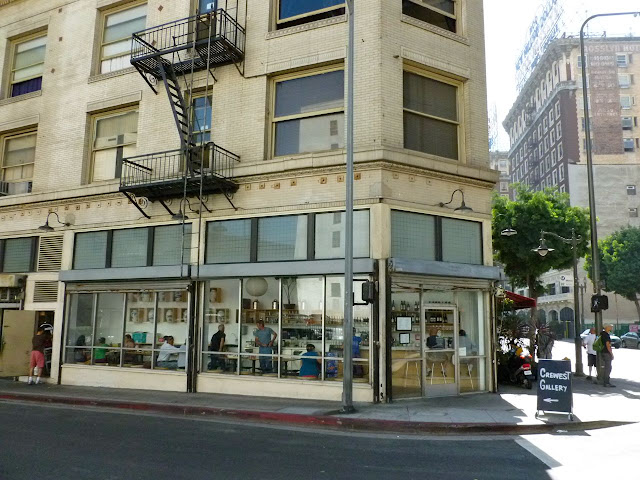Two years ago, I was back in Los Angeles and had a bit of time to explore the Historic Downtown Core. Here's a link to Part I and Part II of this multi part series.
The historic Rowan Building, located on the corner of 5th and Spring, built in 1912 and recently converted into residential units.
Spring Street, looking south (technically, southwest). I turned the corner and headed west (technically, northwest) on 5th Street.
The Last Bookstore - Los Angeles' largest independent bookstore - located at the corner of 5th and Spring Street. This is the entrance off of 5th Street.
The 1913 Jewelry Trades Building - originally known as the Title Guarantee Block - on the corner of 5th and Broadway. This is looking northwest on 5th Street.
Another view of the Jewelry Trades Building.
A local resident with dog in tow.
Downtown Los Angeles has seen a huge influx of new residents. Over 50,000 new residents have more into downtown L.A. since the 1999 enactment of the Adaptive Reuse Ordinance. According to the Downtown L.A. News website - Los Angeles is not as much gentrifying as it is evolving.
Gentrification implies displacing existing residents. For the most part, these new residents are moving into previously empty buildings, or brand new buildings built on former surface parking lots.
Leasing information for the Jewelry Trades Building.
I crossed Broadway and turned around for another view of the Jewelry Trades Building. This is looking north (technically northeast) up Broadway.
Another view looking up Broadway.
The crosswalk at 5th Street & Broadway - looking back north on Broadway..
Looking across the street, south down Broadway towards 6th Street.
While the the addition of 50,000 new residents - with, no doubt, many more to come over the next twenty years - isn't necessarily pushing out a lot of existing residents. However, it is - or eventually will be - replacing retail businesses.
Up until WWII, Broadway was THE upscale shopping district in Los Angeles, with the largest concentration of theaters, departments store, and shopping.
Broadway continues to thrive as a commercial district, catering almost exclusively to working class Latinos.
As a student at UCLA back in the 1980's, a visit to Broadway was a cross cultural experience - it was like another world.
Then, as now, the contrast between the white collar office towers just a few blocks away on Bunker Hill and the sights and sounds of working class Broadway were really incredible.
The Arcade Theater, built in 1910, is one of a dozen surviving movie palaces along Broadway. I was amazed to learn that Broadway (between 3rd and Olympic) has the largest surviving collection of pre-WWII movie palaces in the United States.
There is a push to "bring back Broadway" as a cultural and entertainment hub. The city has recently approved plans to bring a streetcar (light rail) back along Broadway in the near future. Actually, I couldn't find a date when the Broadway streetcar is suppose to be up and running - so maybe not so "near" future.
The ground floor of the Broadway-Spring Arcade Building. The enclosed arcade stretches between Broadway and Spring Streets. This has always reminded me of something you'd find in either Europe or Mexico. According to a wikipedia article, this place was packed with shoppers - mostly from Mexico or Central America - up until the mid 1990's.
Apparently, the previously vacant upper floors were converted to upper end residential in 2003. My guess is that - similar to Spring and Main Streets, these shops will be catering to the influx of new downtown residents in the not so distant future.
A final photo at the corner of 6th and Broadway. More next time in Part IV.
© 2015 www.experiencingla.com
-


















































